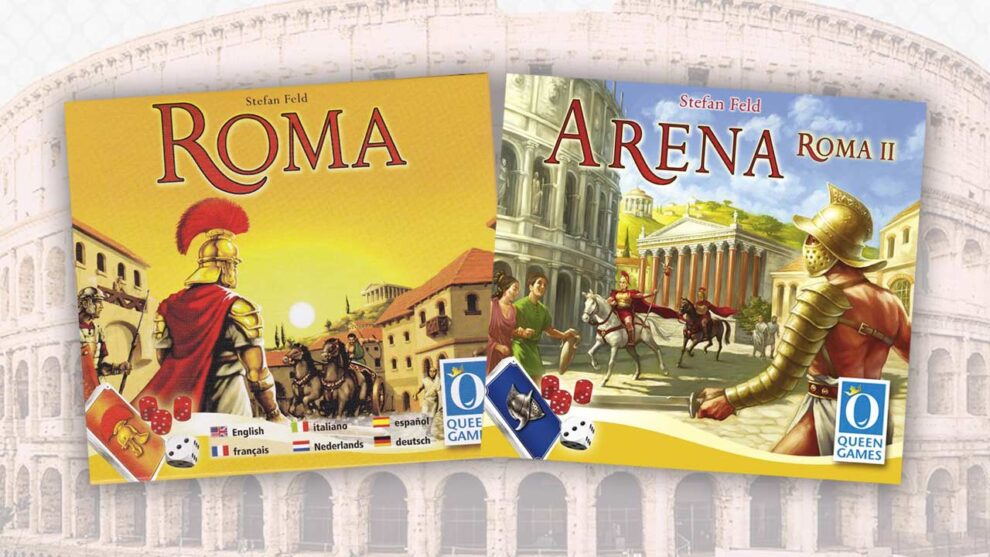Hello and welcome to ‘Focused on Feld’. In this series of reviews, I am working my way through Stefan Feld’s entire catalogue. Over the years, I have hunted down and collected every title he has ever put out. Needless to say, I’m a fan of his work. I’m such a fan, in fact, that when I noticed there were no active Stefan Feld fan groups on Facebook, I created one of my own.
Today we’re going to talk about 2005’s Roma and 2009’s Arena: Roma II, his 1st and 6th games, respectively. Arena: Roma II (Arena) stands out as the first (and, so far, only) time that Feld has released a standalone expansion to a previously published game. Folks that only own one or the other of the two titles can enjoy them separately. Or, if they own both, they can be mixed together in one of several ways for a different experience. These two games also stand out as Feld’s first and second partnerships with Queen Games, a partnership which still flourishes to this day.
Normally, for two different games, I would reserve two different reviews. But, in this case, minus a few differences in components and a few minor differences in the initial setup, the two are so similar as to be the same game. As I discuss the gameplay in the following sections, I will point these out. Since Arena is the more current of the two games, I will use that ruleset during this review.
Setup
First, assemble the icon bar¹, composed of six numbered spaces bookended by a ‘bribery’ space on one end and the ‘money’ and ‘cards’ spaces on the other. Then, each player chooses a color and receives 10 victory points and the Action dice of their chosen color. The remaining victory point chips, the money, and the white Battle die are kept in a supply close by.
If only playing one game or the other, shuffle the cards and use that deck. Otherwise, players with both games should decide how they want to proceed. They can shuffle all cards from both games together and use them as one, giant central deck OR they can each choose to use the cards from one game while their opponent uses the other’s.

After the cards are shuffled, place them face down in a deck. Each player receives five cards², two of which they’ll give to their opponent. Next, each player plays their cards face up³ next to the icon bar in an order of their choosing, one card per space, on their side of the icon bar. The ‘money’ and ‘cards’ spaces cannot accept cards, but the ‘bribery’ spot⁴ can.
Finally, choose a starting player and you’re ready to begin.
¹ Roma uses numbered discs instead of the icon bar, but they’re functionally the same.
² In Roma, it’s four cards.
³ In Roma, cards are placed face down initially and then turned face up once both players have placed their cards.
⁴ This spot does not exist in Roma. It is unique to Arena.
Anatomy of a Turn
Each turn is divided into three phases: evaluate vacant spaces, roll Action dice, and perform actions. Each player will perform all three phases before the next player takes their turn. The first two phases require little explanation. First, the active player will evaluate their side of the icon bar. For each numbered space that does not have a card next to it, they will return a victory point to the supply. Then, they will roll all three of their Action dice and allocate them, optionally re-rolling should all three dice display the same value.
Dice are placed on top of their numbered locations OR on top of the bribery, money, or cards locations on the icon bar. Only one die may be allocated to each of the last three, but any number of same-valued dice may be allocated to the locations matching their values (multiple dice with two pips allocated to the two pip location, for instance). Dice allocated to the ‘money’ or ‘cards’ locations will reward you with an amount of money or cards equal to the pip value of the allocated die, but you only get to keep one of the cards (if that’s the action you chose). Dice allocated to any of the other locations will allow you to perform the actions of the cards at those locations, although using the bribery location will cost you an amount of coin equal to the pip value of the allocated die.

Each card is laid out in the same way. In the upper left corner is the cost associated with playing the card, with the card’s defense value shown just below. At the top right is an icon that serves as a reminder of whether or not a die must be spent in order to use a card’s ability (some cards provide ongoing benefits such as the ability to receive extra coin when using the ‘money’ action) as well as the number of dice involved in using it—some cards display multiple dice icons, indicating multiple dice must be used to carry out the action. In the bottom middle is the name of the card, and the text beneath this explains the card’s ability.⁵ The center features an illustration.
In general, these cards allow you to manipulate other cards by either discarding them outright or engaging in battle with them (rolling the Battle die and comparing it with the attacked card’s defense value to determine the results) or will gain you some amount of coin or victory points for meeting certain conditions. The end goal is to either remove all your opponent’s victory points from their victory point pool before they do the same to you (making you the victor) OR empty the supply of victory points (the player with the most victory points wins). The game continues, turn by turn, until one of these conditions are met.
⁵ Early editions of Roma do not have any text on the cards and iconography is used instead.
Thoughts
As stated earlier, when it comes to Roma and Arena, there is no appreciable difference between the two. But, if you tasked me with recommending one or the other, I’d lean more towards Arena over its counterpart. The production value is slightly better, the bribery space provides flexibility that Roma is lacking, and it removes the pointless setup condition from Roma which has the players placing their cards face down. If you were guaranteed to be able to activate a specific card at any given time, this restriction would make sense. But, since the activation of any given card is entirely dependent on the roll of the dice, there’s really no need for it.
That being said, these games really shine when they’re mixed together. It’s my favorite way of playing them, and not just because shuffling everything together into a single giant deck is super lazy, which it is (and I’m all for taking the path of least resistance when it presents itself to me). It’s because each game features a wide range of interesting ideas about how to interact with the game space, and it’s fun to see how those ideas meld to create something fresh and unexpected from one game to the next. It’s pretty great.
 Not everything is sunshine and roses, though. I do have a few minor quibbles. For starters, the rule books across both games could have stood some additional editing. Not only is the wording inconsistent from one to the next (for instance, Roma tells us about the “Playing Equipment” while Arena tells us about the “Game Components”), but the card summary at the back of the Arena rulebook displays the incorrect text for the Forum card, re-using the text for the Fortuna card instead. Also, nowhere in the rules are the players told how to handle a game that ends in a tie. But, my biggest minor quibble is that, aside from a single character card in Roma—which, when activated, allows you to adjust the pip values on one of your dice—there is no method for mitigating your dice rolls. You are always at the mercy of the whims of fate.
Not everything is sunshine and roses, though. I do have a few minor quibbles. For starters, the rule books across both games could have stood some additional editing. Not only is the wording inconsistent from one to the next (for instance, Roma tells us about the “Playing Equipment” while Arena tells us about the “Game Components”), but the card summary at the back of the Arena rulebook displays the incorrect text for the Forum card, re-using the text for the Fortuna card instead. Also, nowhere in the rules are the players told how to handle a game that ends in a tie. But, my biggest minor quibble is that, aside from a single character card in Roma—which, when activated, allows you to adjust the pip values on one of your dice—there is no method for mitigating your dice rolls. You are always at the mercy of the whims of fate.
Usually, that would be a death knell in a game that has such a dependence on dice. However, in Roma and Arena, there’s always something useful to do, even if you don’t necessarily like doing it. Even if the dice you rolled don’t sync up with any of the cards you’ve played, you can always get yourself some more money or draw another card. And, since you have three dice, if you’re lucky enough, you might even be able to do those AND play the card you just drew on the same turn. That’s important because preventing the hemorrhaging of points by getting cards into play is just as important as gaining even more.
The Roma/Arena experience is a purely tactical one. The nature of the game makes long-term planning impossible. Depending on the type of person you are and the games you enjoy playing, that could be a limiting factor for you. But, if you’re in the market for a relatively quick and easy two-player game where the game state can shift dynamically, you can’t go wrong with either, or both, of these.











